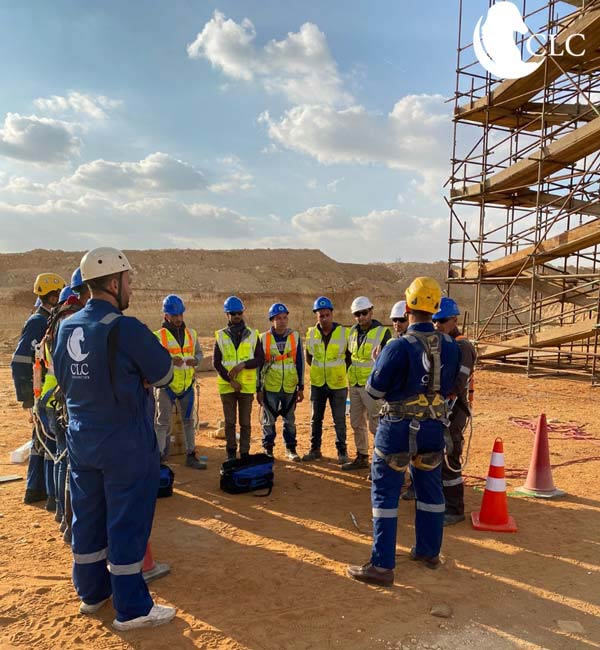
Working at Heights Training for Safer Job Sites
Working at Heights Training is a fundamental element to ensure a safe work environment according to the highest global standards.
Working at heights is considered one of the most hazardous tasks in the construction sector and requires specialized skills and thorough knowledge of safety procedures to prevent accidents and injuries.
Therefore, CLC Company is committed to providing specialized training programs aimed at qualifying workers and raising their awareness of best practices to protect themselves while performing work at heights. In this article, we will cover all the essential details about Working at Heights Training.
Working at Heights Training
Working at Heights Training is one of the essential elements to ensure a safe work environment according to the highest global standards.
Working at heights is considered one of the most hazardous tasks in the contracting sector, requiring special skills and thorough knowledge of safety procedures to avoid accidents and injuries.
Therefore, CLC Company is committed to providing specialized training programs aimed at qualifying workers and enhancing their awareness of best practices to protect themselves while performing work at heights. In this article, we will explore all the details related to Working at Heights Training.
Requirements for Working at Heights Training
Workers operating at elevated locations must meet a set of basic requirements to ensure their ability to perform tasks safely and efficiently.
These include personal and technical qualifications, compliance with regulations governing this type of work, and completion of Working at Heights Training.
Essential Qualifications for Workers
Workers must be in good physical condition, as working at heights requires balance, physical endurance, and strong concentration skills to avoid mistakes that could lead to serious risks.
Basic knowledge of safety equipment use, such as safety harnesses and helmets, ensures protection during work and the ability to follow instructions accurately. Safe work relies heavily on adherence to provided guidelines and training.
Laws and Regulations Governing Work at Heights
Regulatory bodies impose strict standards to ensure worker safety, including the use of safety equipment approved by competent authorities.
Companies must provide regular training courses to ensure workers comply with the latest safety procedures on elevated work sites.
The law mandates periodic inspections of equipment to verify its safety and reduce accident risks, Companies are also required to provide comprehensive health insurance for workers in hazardous environments to guarantee their protection in case of injury.
Training Program Content
The Working at Heights Training program focuses on equipping workers with the knowledge and skills needed to ensure their safety while performing tasks at elevated sites’ The training includes:
- Introduction to basic equipment.
- Use of safety tools.
- Effective emergency response.
Introduction to Equipment for Working at Heights
The training provides detailed explanations of the equipment used, such as:
- Ladders.
- Scaffolding
- Fall protection ropes.
Workers are trained on selecting the appropriate equipment for each work environment to maximize safety.
The program includes regular equipment inspections before use and practical demonstrations on how to properly wear and use each tool according to international standards.
How to Use Safety Tools Like Harnesses and Helmets
Participants learn the correct way to wear safety harnesses and securely attach them to reliable anchor points. The importance of using protective helmets to prevent injuries from falling tools or materials is emphasized.
Trainees also learn how to adjust protective equipment for maximum comfort and safety during work, The training includes practical scenarios simulating real work environments to ensure proper understanding of tool usage.
Emergency Procedures and Handling Potential Accidents
The program covers steps for managing emergency fall situations to minimize possible injuries. Teams are trained to provide quick first aid to colleagues in case of an accident.
Workers also learn safe evacuation methods during emergencies such as fires or scaffold collapses, Practical drills on rescue systems and accident reporting procedures ensure prompt response.
Potential Risks of Working at Heights
Working at Heights Training is one of the fundamental factors that help reduce the risks workers face while performing tasks at elevated locations.
These risks can lead to severe injuries or even fatalities. Therefore, Al Asema Contracting Company offers Working at Heights Training to help avoid hazards such as:
- Risk of Falling from Heights
Falls are among the most common hazards when working at heights, especially when using ladders, scaffolds, or unstable surfaces.
The absence of protective equipment, such as safety harnesses or guardrail,s can expose workers to serious injuries, Working at Heights Training teaches workers:
- How to reduce the chances of falling.
Safety standards rely on proper securing procedures, such as anchoring points and inspecting equipment before use.
- Falling Tools and Equipment
Tools or equipment that are not properly secured can cause serious accidents to workers below. It is essential to use safety nets or securing systems to prevent equipment from falling from heights.
Working at Heights Training provides clear guidelines on how to properly secure and store tools, helping reduce injuries and promoting a safer work environment.
- Risks of Electric Shocks and Fires
Working near electrical lines or high-voltage equipment poses a significant danger to workers. Contact with electrical cables may cause potentially fatal electric shocks.
Working at Heights Training includes safety procedures for handling electrical sources and reducing fire risks. Wearing appropriate protective gear and ensuring electrical sources are isolated before work begins is mandatory.
- Impact of Adverse Weather Conditions
Strong winds, heavy rain, or dense fog can increase the risk of losing balance while working, and slippery surfaces reduce control, increasing the likelihood of falls.
Working at Heights Training raises workers’ awareness of best practices when facing unstable weather conditions. Work should be postponed during harsh weather to ensure workers’ safety and reduce potential risks.
- Exposure to Toxic Gases and Chemicals
In some work environments, workers may be exposed to inhaling toxic gases or handling hazardous chemicals, Lack of protective measures can cause serious health problems, such as poisoning or respiratory irritation.
Working at Heights Training covers procedures for handling hazardous materials and the correct use of personal protective equipment, including wearing masks and appropriate clothing, to minimize negative effects.
- Risks of Heat and Cold Stress
Working in extreme weather conditions, whether very hot or cold, poses health challenges for workers. Heat stress can lead to exhaustion and dehydration, while low temperatures can cause hypothermia.
Working at Heights Training offers guidance on how to cope with extreme temperatures to maintain worker safety, It is important to:
Wear suitable clothing.
Drink sufficient amounts of water.
Take regular breaks to avoid health risks.
- Fatigue and Loss of Concentration
Working long hours at heights can cause mental and physical fatigue, increasing the risk of errors, Loss of concentration may lead to wrong decisions, causing serious accidents.
Working at Heights Training helps develop focus skills and teaches workers how to manage work-related fatigue, Scheduling regular breaks is recommended to maintain alertness and reduce accident risks.
CLC Company provides comprehensive Working at Heights Training programs to ensure a safer and more efficient work environment.
The Role of CLC Company in Worker Training
CLC Company is one of the leading companies providing Working at Heights Training in Egypt, It is distinguished by offering the highest standards of safety and efficiency through specially designed working at heights training programs to ensure worker protection and skill enhancement. The company relies on:
- The latest approved technologies and equipment.
- A specialized team for training and risk management.
- Customized solutions suitable for various work environments.
- Providing high-level rescue courses for workers.
- In addition to training programs, specialized courses such as crane operation training.
- Safety instructions for forklifts.
- Along with safety and security courses.
Therefore, CLC Company leads the list of top companies in Egypt, If you want a safer and more efficient work environment, you can contact us to benefit from our training programs.
Frequently Asked Questions
What is the Working at Heights Training course?
The Working at Heights Training course by CLC Company is a comprehensive training program designed to qualify workers to operate safely and efficiently in elevated environments. The course includes:
- Practical training.
- Use of modern safety equipment.
- Managing potential hazards.
- Implementing emergency procedures according to the highest standards.
- A specialized team.
- Customized training solutions.
The company ensures raising safety levels and reducing risks at work sites.
What are the most important safety rules for working at heights?
The key safety rules for working at heights include:
- Using personal protective equipment PPE.
- Ensuring ladders and platforms are stable.
- Training workers on safety procedures.
- Securing tools and equipment.
- Adhering to emergency procedures.
CLC Company offers specialized training programs to guarantee the effective application of these rules and to enhance worker safety


Leave a Reply